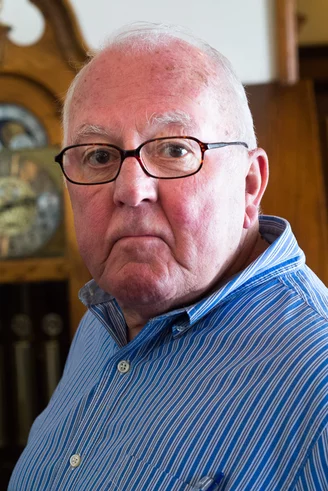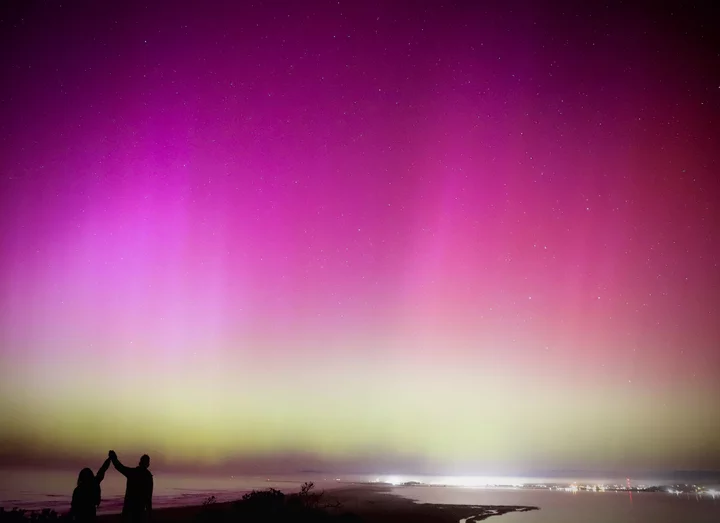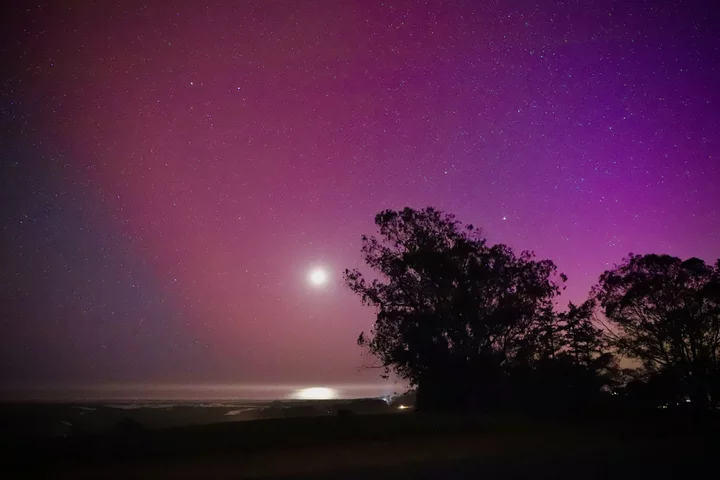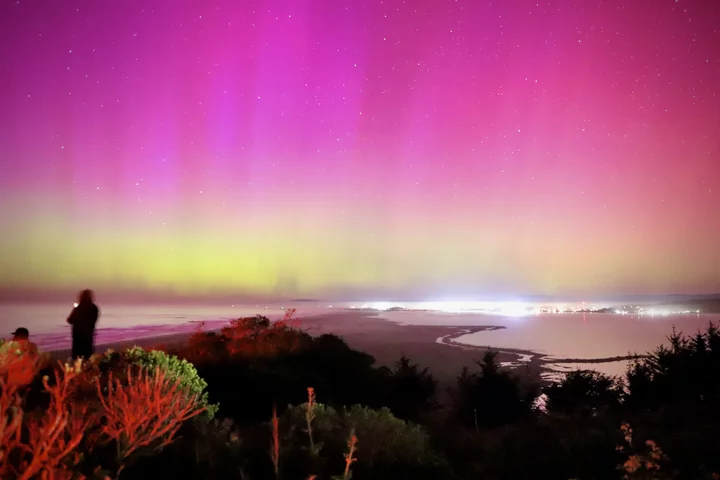THE ECONEWS REPORT: In-Stream Flows Set to Expire for Klamath Tributaries. What’s Next?
LoCO Staff / Saturday, May 11, 2024 @ 10 a.m. / Environment
Illustration: Stable Diffusion.
The
Scott and Shasta Rivers were once salmon strongholds, but
over-allocation of water has made these rivers nearly uninhabitable
for coho and chinook. The State Water Resources Control Board
established emergency regulations that set minimum streamflows during
the
most
recent drought. But those will likely expire soon. Without new
permanent instream flows, both rivers could run dry.
A coalition of tribal governments, fishermen and environmental nonprofits are asking the State Board for new permanent instream flow dedications. And new legislation, if passed, will strengthen the ability of the state to protect those instream flows. Karuk Vice-Chairman Kenneth Brink, Cody Phillips of the California Coastkeeper Alliance, and Klamath advocate Craig Tucker join the EcoNews to talk about what’s needed to save California’s salmon.
Let Senator McGuire know that you support AB 460 and AB 1337.
BOOKED
Today: 5 felonies, 11 misdemeanors, 1 infractions
JUDGED
Humboldt County Superior Court Calendar: Today
CHP REPORTS
Shelter Cove Rd / Toth Rd (HM office): Car Fire
ELSEWHERE
Governor’s Office: Governor Newsom issues proclamation declaring 2026 statewide primary election date
Governor’s Office: Governor Newsom issues statement on Trump administration’s vaccine schedule endangering the lives of infants and children
Governor’s Office: One year after Los Angeles firestorms, California continues all-of-government community recovery efforts
RHBB: Road Conditions Update from Humboldt County Public Works
HUMBOLDT HISTORY: The Humboldt County Teacher Who Flew Before the Wright Brothers, and the Forgotten Precious Blood Catholic School in Rohnerville That Hired Him
Glen Nash / Saturday, May 11, 2024 @ 7:30 a.m. / History
John J. Montgomery’s “Evergreen” glider is shown being flown by Joseph C. Vierra at Fruitland in San Diego County. Note the wood rails to facilitate takeoff. Montgomery was killed while flying this craft on Oct. 31, 1911. Photos via the Humboldt Historian.
One day, in about the year 1920, when I was attending the Marshall School in Eureka, in the fifth grade, we had a history lesson on the invention of the airplane and the Wright brothers.
Airplanes were not too plentiful in Humboldt County in those days. The class was really interested in the subject when one of the students, a small girl (I remember she had her hair in long dark curls), raised her hand for permission to speak and this is what she said: “My uncle invented the airplane and flew it before the Wright Brothers flew theirs and they stole the idea from him for their airplane.” This small girl’s name was Dorothy Montgomery. No one at the time seemed to pay attention to her, but to this day what she said has haunted me.
One day I saw an article in the San Francisco Examiner dated Thursday, July 14, 1960, which told of the Rev. Arthur D. Spearman, a university archivist, giving a lecture about a man named John J. Montgomery who had discovered the basic laws of aerodynamics and had made his flight in August 1883, eight years before the Wright brothers’ venture at Kitty Hawk. Father Spearman had “conclusive evidence” to back up his statement. His lecture was part of a series at the University of Santa Clara Campus held in the Saisset Art Gallery.
I wrote to the University of Santa Clara and I received an answer from their archivist, including information about Mr. John Joseph Montgomery.
From this information and other data which I have been able to obtain, I will attempt to write the history of the first airplane flights and experiments in Humboldt County by John Joseph Montgomery.
But first, I would like to give a history of the college of Saint Joseph at Rohnerville, where Montgomery served on the faculty.
In the year 1868, Father Patrick Henneberry CPPS, of the Precious Blood Fathers, was appointed pastor of Eureka, Calif. During this time. Father Henneberry was determined to build a residential school for boys and after a search a suitable site was found at Rohnerville. The owner of this property, James Degnan, donated 30 acres, 12 of which were flat and the remainder on a high bluff overlooking the countryside and the Eel River. The site was sometimes called College Heights.
A traveler on Highway 101, a few miles south of Fortuna, can look up to the bluff on the east overlooking Alton. This is where the Rohnerville airport is located and this was the site of Saint Joseph College.
Father Henneberry let the contract for the new building in 1869. It was designed by Rohnerville resident M.N. Lockington. The magnificent edifice was described as “Ionian style” architecture. The lumber was brought from Eureka but other materials were purchased in San Francisco, shipped by steamer to Humboldt Bay and hauled by wagon to the site. Construction was handled by contractors Masson and Campton.
The new building had two floors and an attic floor. It was 170 feet long and 46 feet wide, with the central portion wider than the two ends. A corridor eight feet wide ran 129 feet, almost the length of the building. There were 62 doors, 97 windows and eight skylights. The building was built of wood and plastered interior. It contained many fireplaces, needed because of the damp climate in the Humboldt area.
On the ground floor there were three parlors, the bishop’s room, two dining rooms, two recreation rooms and eleven bedrooms. The second floor included two piano rooms, six bedrooms, the infirmary, study hall, classrooms, library, chapel and rooms for the priests and professors. The third floor dormitory was topped by a promenade surrounded by an iron railing with a 20-foot cupola. Nine carpenters, three painters and two bricklayers, as well as a laborer, were kept busy all through 1870 and most of 1871 until the building was completed in September 1871 at a cost of $16,000.
The new school was widely advertised and when classes began on January 16, 1872, there were 100 students, both boarders and day pupils.
When the college opened, the community of priests, brothers and seminarians moved from Eureka to the new building. Father Henneberry resigned as pastor of Eureka and was appointed superior of the new college. Father Dickman was appointed the new pastor of Eureka when the Precious Blood community moved from their building in Eureka to the new college in Rohnerville.
The Sisters of Mercy arrived in Eureka in May 1871 and took over the building in Eureka, which was located on the property where the Eureka Inn is located today. When I was a small boy I remember seeing this building on a full block on Seventh Street between F and G streets. A playground was on the Eighth Street side and there were always a lot of kids playing there. This block had cypress trees all around like a big hedge and the kids, including this writer, could go all around the block in these trees and our feet would not touch the ground.
From the day the college’s doors opened in January 1872, St. Joseph’s was plagued by never-ending financial problems. The school was materially aided by the Mother-house in Ohio, but the cost of operating in an isolated area was more than anticipated. Debts piled up against the college and Father Henneberry left his beloved school in the fall of 1875 to begin a ten-year fund raising crusade. Despite his efforts and those of the staff in charge at St. Joseph’s, the Mother-house ordered the school closed. The closure came on September 17, 1877.
Through Henneberry’s dedicated efforts, the college was reopened in January 1894, but finances were again a problem and Henneberry was forced to seek community aid. Rohnerville merchant L. Feiganbaum loaned Henneberry money on several occasions, as did the Ferndale Bank, Philip Brody and others. Father Henneberry died on December 19, 1897, in Virginia City, Nevada, while on a mission and he is buried there among the pioneers of the Comstock Lode.
Final disposition of the property came in the spring of 1899 when Joseph Feiganbaum purchased it from the Henneberry estate. The Degnan family, donors of the land to Henneberry in 1871, bought it back from the Feiganbaum estate in 1921 and the building was demolished shortly thereafter.
###
John Joseph Montgomery was born on February 15,1858, in Yuba City, Calif. His father, Zachariah Montgomery, was a lawyer, public servant and journalist. His mother, Ellen Envoy Montgomery, was the daughter of the celebrated Temescal pioneer, Bridget Shannon Evoy, “probably the only woman who led a covered wagon train across the plains in 1849-1850.”
In 1864 John moved to Oakland, Calif., where it is believed he began his study of bird’s flight and wing structure. He entered Santa Clara College in 1874 and transferred in 1875 to St. Ignatius College in San Francisco where he earned his B.S. Degree in 1879 and his M.S. Degree in 1880. In 1893 he presented his paper “Soaring Flight” at the Aeronautical Congress Conference on Aerial Navigation, in Chicago, having accomplished the first controlled flight of man in a heavier-than-air craft at Otay Mesa around 1883 or 1884. In 1882 he joined his family at their farm near Fruitland in San Diego County where he soon preempted their barn for a laboratory. The following year marked a milestone in aviation history — John Montgomery made man’s first controlled flight in a heavier-than-aircraft.
In 1894, Montgomery began teaching mathematics at St. Joseph’s College in Rohnerville. Father Spearman believes Montgomery constructed two small airplanes at Rohnerville — The Pink Maiden, a tandem wing model with a three-foot, six-inch wingspread, and The Buzzard, a four-foot wingspread model. Certainly the wind currents rising up the Eel River to sweep the bluff where the college stood were ample for observation and experimentation.
Montgomery stands with one of his glider models in a Santa Clara vineyard in about 1904.
He returned to his family home in
1895 and began living at Santa Clara
College in 1896, where he was awarded
his Ph.D. in 1901. While at Santa Clara
he worked with James E. Leonard, flying three and four-foot wingspread
models. Montgomery tested these models at the Leonard Ranch near Aptos on
Monterey Bay by flying them from a
trestle.
It was from the Otay Mesa rim at Wheeler Hill, in San Diego County, that John Montgomery and his brother James, launched their first flight on August 28, 1883. The brothers had loaded the frail, 38-pound craft into a hayrack at their Fruitland ranch barn early in the morning to avoid prying eyes.
Neighbors knew about Montgomery’s experimenting and realized that he hoped to fly. The consensus was that he was a little crazy to be attempting such a fete. Therefore, the aircraft was covered with straw, and both men carried hunting rifles so that if they met any curious Questioners, they could explain their early start as the beginning of a hunting trip.
The brothers arrived at the rim and unloaded the craft. James Montgomery attached a light rope to the bottom of the craft to counteract any sudden strong gust of wind and took his place, rope in hand, 12 to 14 feet below the rim. John called “NOW!” His brother yanked the rope and the fragile craft rose off the cliff and immediately became airborne. From that moment Montgomery knew that he had begun the mastery of the air.
It was long before a printed account of Montgomery’s flight appeared. Octave Chanute recorded the flight in his “Progress in Flying Machines,” published as a book by the American Engineer and Railroad Journal at New York in 1894.

Daniel Maloney, daredevil balloonist and test pilot, is seen as he is about to release one of John J. Montgomery’s gliders for a flight to earth. Maloney was killed in 1905 during one of these tests when the glider crashed.
John Montgomery made many experiments with aircraft, including the use of a hot air balloon used to take the airplane up to thousands of feet, where the plane was cut loose to fly and glide back to the earth.
One daring young aeronaut, Daniel John Maloney, had performed this stunt many times to the amazement of many spectators. After successful plane demonstrations in March 1905, Montgomery wanted to take Hamilton’s balloon to Santa Clara College in July 1905.
It was a bright morning, July 18, 1905, the air was still and the sun bright. The balloon was filled with hot gases from a fire fed with kerosene and Maloney’s plane was fastened to it. It rose to 4,000 feet, Maloney cut loose but was entangled in a hold down line and could not maneuver the plane and it crashed to the ground, killing him.
Before this tragedy, Daniel Maloney, in 1905, was the first man in the world to loop-the-loop in an airplane.
Maloney’s death was a terrible blow to Montgomery who lost his most devoted friend and aeronaut.
During the years that followed, there were many experiments and flights by Montgomery. Montgomery’s work in perfecting his monoplane, the Evergreen, came at the time of his marriage to Regina M. Cleary of San Francisco on June 30,1910. Regina Cleary was a very beautiful woman and a talented pianist, as well as a writer of verse. The couple lived in a house at Santa Clara.
In October 1911, Montgomery, Regina, and his two mechanics, Cornelius Reinhardt and Joseph Vierra, took two tents, an assembly workbench and the new monoplane Evergreen to a site on the hill slopes of the Ramonda Ranch in Evergreen Valley, just south of San Jose. Here on a friendly rancher’s land, in a hollow slope within the high area east of the San Felipe Road, he laid simple wooden rails down from the crest. This launching site faced toward the prevailing northwest breeze for flight take-offs.
Reinhardt, a German, was an expert mechanic. He could make any part or gadget that Montgomery needed. During the preliminaries at Evergreen, when they were assembling the aircraft, Reinhardt was worried by the over-protrusion of stove bolts. These bolts were used to hold the main wing supports to the fuselage. The bolt ends protruded inward above the head of the pilot.
For two weeks, October 17 through 31,1911, Montgomery and Vierra alternated in accomplishing a total of some 55 successful flights. These included gliding, rising, manuvering, and then circling back to the hilltop. Occasional practice landings were made in the grassy bottom land.
After watching Vierra in flight, Montgomery thought some slight change in angle could result in some valuable information. On October 31, Montgomery changed the angle of incidence on the cambered horizontal stablizer. After making the adjustment, Montgomery got aboard the plane and shot down the wooden rails and quickly became airborne. Suddenly, when the aircraft was just off the rails, it pointed abruptly upward. Reinhardt said he saw Montgomery lean forward in his rocker seat, a puzzled look on his face as he tried hard to stablize the craft. Montgomery had moved to force the center of gravity forward and to reduce the angle of attack of the wing. Strong physical pull or push on the yoke control wheel and leaning forward or backward were still important elements in controlling his plane. While airborne at between 13 feet, as Reinhardt figured, and 23 feet as Vierra reckoned, the fragile craft stalled, side slipped and fell gently striking the right wing tip on the ground. The plane overturned.
Reinhardt rushed to the scene and gently lifted Montgomery from the fuselage. He saw blood and grey matter oozing from behind the inventor’s right ear where one of those stove bolts had pierced his head. Regina had seen the plane fall and hurried up the hill. Vierra sped to the Ramonda Ranch house to telephone for a doctor. The doctor took the wrong road and when he arrived two hours later, John J. Montgomery was dead.
Montgomery was described by his intimate friends as a very humble, secretive man when in the public eye, but at home among friends and family he was really very jolly, pleasant, and fond of humor. He liked to tell stories and entertain with electrical tricks. Montgomery had the fault of many inventors, he was stubborn. Fixedness of purpose both made and destroyed his life’s pattern.
###
The story above was originally printed in the March-April 1989 issue of the Humboldt Historian, a journal of the Humboldt County Historical Society. It is reprinted here with permission. The Humboldt County Historical Society is a nonprofit organization devoted to archiving, preserving and sharing Humboldt County’s rich history. You can become a member and receive a year’s worth of new issues of The Humboldt Historian at this link.
OBITUARY: Fil Godfrey, 1940-2024
LoCO Staff / Saturday, May 11, 2024 @ 6:56 a.m. / Obits
August F Godfrey Jr., born on June
28, 1940, passed away on May 3, 2024.
Fil was a father to Steven Godfrey of Renton, Wash., and Stacey Godfrey Celeste of Eureka. He was proud to be the grandfather of Daniel and Will Godfrey, and Thomas Celeste. He will be missed by his friends Kathy Foley Spain, Kevin Phillips and Roberta Walker.
Fil was born and raised in Eureka. After graduating from Eureka High School, he spent several years in the US Air Force, stationed in Spain. Upon returning home, he married his high school sweetheart, Sarah Goldberg (Godfrey). They had the first Jewish wedding ceremony in Eureka, and were founding members of Temple Beth El in Eureka. After Sarah’s death, Fil never remarried.
He spent over 40 years working at Maurice’s shoe store alongside his wife Sarah and her parents, Maurice and Florence (Fil was a patient man). Later, he spent several happy years working at Allure Jewelers.
Fil enjoyed visiting local forests and parks and spending time working in his back yard. A quietly creative individual, his endeavors included growing and arranging flowers and pastel drawings. He loved visiting art galleries and appreciated the work of local artists.
His greatest joy was friends and family. Fil was warm and welcomed everyone to his home, genuinely interested in how they were doing. In later years, he considered himself blessed to have his daughter Stacey nearby, as she and her friends kept his life rich and interesting. He was a lifelong resident of Eureka, and will be greatly missed.
He is survived by his children and grandchildren, and his sisters-in-law Rose Ann Watson of Roseville and Nancy Godfrey of Santa Rosa.
A graveside service will be held at Sunset Memorial Park on Friday, May 24 at 1 p.m.
In lieu of flowers, the family suggests you make a donation to Hospice of Humboldt County or plant a plant of your choice in Fil’s memory that will always remind you of him.
###
The obituary above was submitted on behalf of Fil Godfrey’s loved ones. The Lost Coast Outpost runs obituaries of Humboldt County residents at no charge. See guidelines here.
OBITUARY: Dennis (Denny) Phillip Katri, 1944-2024
LoCO Staff / Saturday, May 11, 2024 @ 6:56 a.m. / Obits
Dennis
(Denny) Phillip Katri, 79, was tragically taken from us on March 27,
2024, as the result of an auto accident. His loss
was completely unexpected and we are still in shock and miss him so
much.
Denny was born on May 28, 1944, in San Francisco, where he was adopted as an infant by Phil and Bettie Katri. He grew up in Humboldt County where he attended local elementary schools and St. Bernard’s High School, but ended up graduating from Eureka High School in 1962.
Denny married his high school sweetheart, Sharon Hastings, in 1964 and they made their home here in Eureka, where they raised their children. He spent many years working at Louisiana Pacific Pulp Mill before becoming a self-employed electrical contractor.
Throughout the years, Denny enjoyed spending time with his family at the cabin in Suntan Glen, fishing, golfing, watching sporting events, going to the horse races, going to the casino, and volunteering countless hours at St. Bernard’s High School. Most of all, he was a true family man and especially loved being around his grandchildren and great grandchildren. He was so proud of all of them and the smile on his face when he was with them said it all. One of his favorite things to do was to take them to breakfast, which always had to include his favorite, Swedish pancakes. Denny also enjoyed the time he spent with his good friends Ralph and Virginia Norling, Dave and Teresa Franceschi, Jerry and Cindy Bruga, just to mention a few. He will be missed by everyone who knew him and will live forever in our hearts.
Denny is survived by his daughter, Shelly (Todd) Rice; son, JJ (Aarin) Katri; grandchildren, Hayley (James) Pastori, Hunter Rice, Abiona and Sawyer Katri; great grandchildren, Dawsyn and Rye Pastori; brother, John (Lenore) Katri, and many other extended family members. Denny was preceded in death by his daughter, Kimberly; wife, Sharon; and his parents.
Please join us for a celebration of life on Saturday May 25, 2024 at Old Growth Cellars in Eureka from 1 to 4 p.m. We look forward to hearing stories and memories you may have about Denny.
###
The obituary above was submitted on behalf of Denny Katri’s loved ones. The Lost Coast Outpost runs obituaries of Humboldt County residents at no charge. See guidelines here.
OBITUARY: Kathryn Hubbard Stotler, 1952-2024
LoCO Staff / Saturday, May 11, 2024 @ 6:56 a.m. / Obits
Kathryn Hubbard Stotler
April 6, 1952-May 8, 2024
Kathryn was born on April 6, 1952, in Muncie, Indiana to Carolyn and Charles Meredith Hubbard. Her family moved six years later from the Midwest to Southern California. Her father had accepted a teaching position with the music department of Cal State LA.
Kathryn was married to Chuck Stotler for 45 years. Many of those years they resided in Monterey, where Kathryn taught special education classes for 8 years before shifting to real estate sales. They moved to Arcata in 1990 after the birth of their son, Thomas. Soon after that, their daughter, Haley, was born.
Kathy loved the arts and was very involved in the local arts community. For several years she wove colorful blankets and sold them in various cities nationally, before shifting to abstract painting. She captured an aliveness of the coastal elements in abstract form.
Kathy is predeceased by her parents and is survived by her brother Richard Hubbard, as well as her sister Cindy, her sister-in-law Diane Turner and husband Larry Turner, niece Elizabeth, husband Rob Faus, and their son Reo. She is also survived by her husband, Chuck Stotler, son Thomas Stotler, daughter Haley Grimm, son-in-law Colin Grimm and grandson Austin Grimm.
Kathy will be missed most for her cheerfulness, engaging personality, and intelligence. Pancreatic cancer may have stopped her from creating works of art, but her beauty, intelligence, and kindness will live on for those who were lucky enough to have known her.
###
The obituary above was submitted on behalf of Kathy Stotler’s loved ones. The Lost Coast Outpost runs obituaries of Humboldt County residents at no charge. See guidelines here.
Look Up
Andrew Goff / Saturday, May 11, 2024 @ midnight / Pictures
The aurora borealis, AKA northern lights, seen here over Eureka from Table Bluff
The largest geomagnetic storm in nearly two decades is sure fun to point your camera at.
People from across Humboldt are sharing their photos of the aurora borealis on the Outpost’s Facebook page. (Also here.) You might want to add yours to the pile.
ALERT: Potential Measles Exposure in Two Eureka Locations
LoCO Staff / Friday, May 10, 2024 @ 4:53 p.m. / Health
Humboldt County Department of Health and Human Services:
Individuals who visited the Days Inn in Eureka or the Providence St. Joseph Hospital Emergency Department during the following days may have been exposed to measles:
- The Days Inn by Wyndham, 270 Fifth St. in Eureka from Thursday, May 9, at 2 p.m. through Friday, May 10, at 3 a.m.
- Providence St. Joseph Hospital Emergency Department, 2700 Dolbeer St. in Eureka Friday, May 10, between 2:30 a.m. and 6:30 a.m.
Anyone who was inside these locations during these times should contact the Public Health Branch of the Humboldt County Department of Health & Human Services at 707-268-2182, whether or not you are experiencing symptoms. Phones will be answered this evening until 8 p.m. and Saturday from 8 a.m. to 8 p.m.
A Public Health nurse will evaluate your possible exposure and provide information. For unvaccinated individuals, vaccination within 72 hours of exposure can greatly reduce the risk of serious illness.
Earlier today, Public Health was notified that a family traveling through the area included an individual who was seen at St. Joseph Hospital’s Emergency Department with a confirmed case of measles.
According to the California Department of Public Health, measles is a highly contagious virus that lives in the nose and throat mucus of an infected person. It can spread to others through coughing and sneezing. The virus can live for up to one hour in an airspace after the infected person leaves the area, and other people who breathe the contaminated air or touch the infected surface, then touch their eyes, noses or mouths can become infected.It can take anywhere from 7 to 21 days to develop symptoms after exposure to measles, and symptoms usually begin with a fever that lasts for a couple of days, followed by a cough, runny nose, conjunctivitis (pink eye) and a rash. The rash typically appears first on the face, along the hairline and behind the ears and then affects the rest of the body. Infected people are usually contagious from about four days before their rash starts to four days afterward. Children under 5 years old and people who are pregnant or have compromised immune systems are at highest risk for severe disease and complications from measles.
Measles is a vaccine-preventable illness. The measles, mumps and rubella (MMR) vaccine is 97% effective at preventing illness. For more information about the vaccine, contact your primary care provider and visit https://www.cdc.gov/measles/vaccination.html.
Most children and young adults’ digital vaccination records are available through the California Department of Public Health’s Digital Vaccine Record: https://myvaccinerecord.cdph.ca.gov/.












